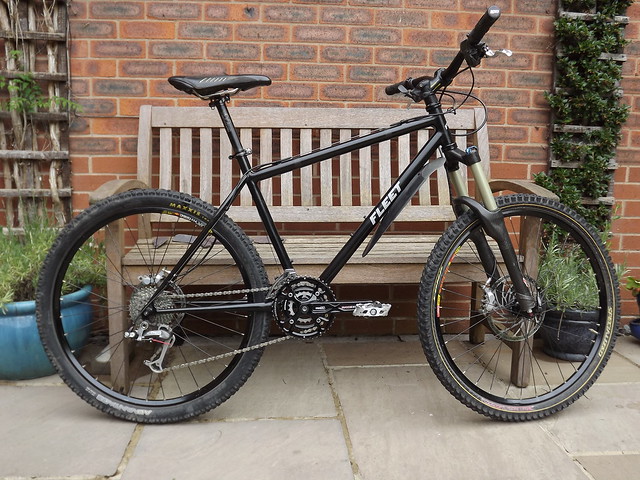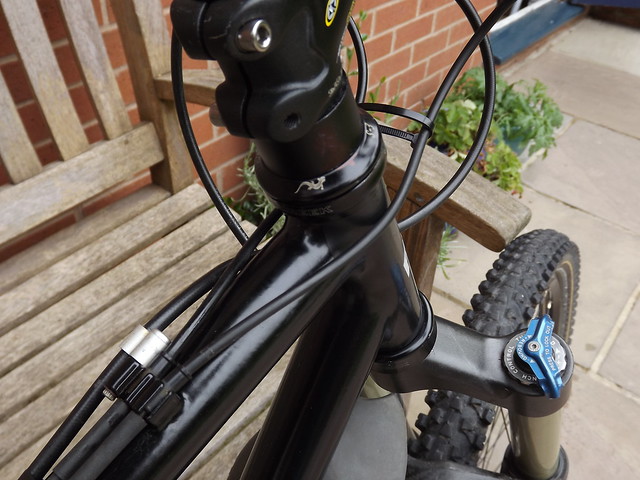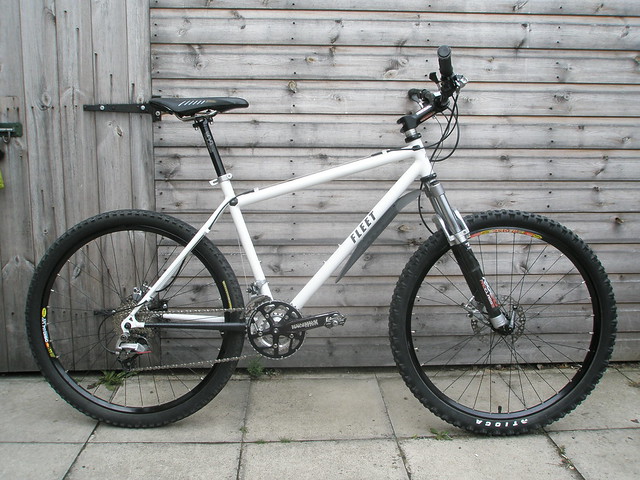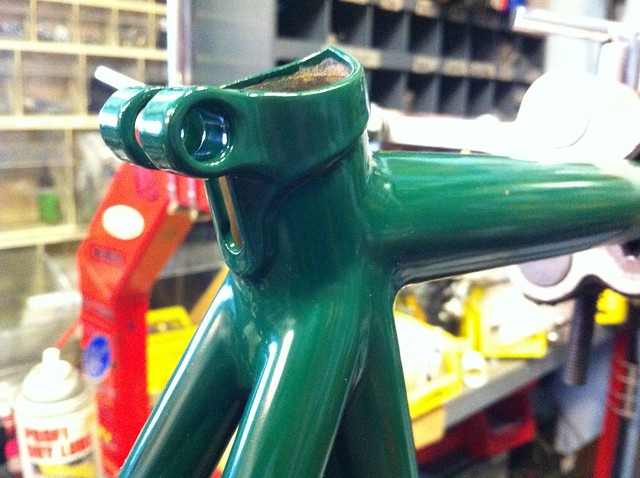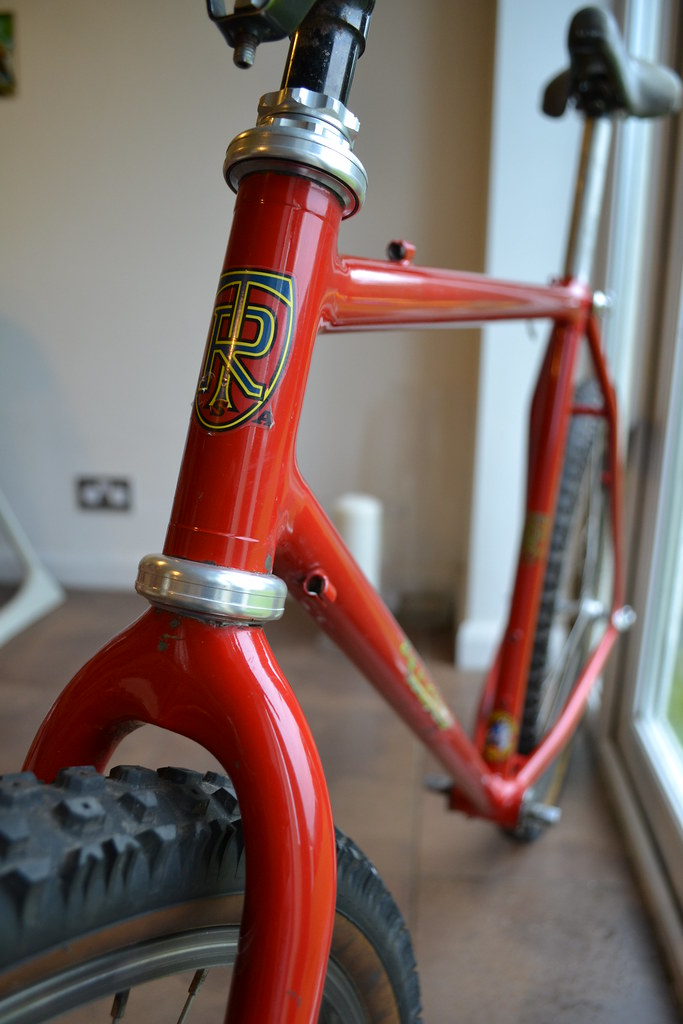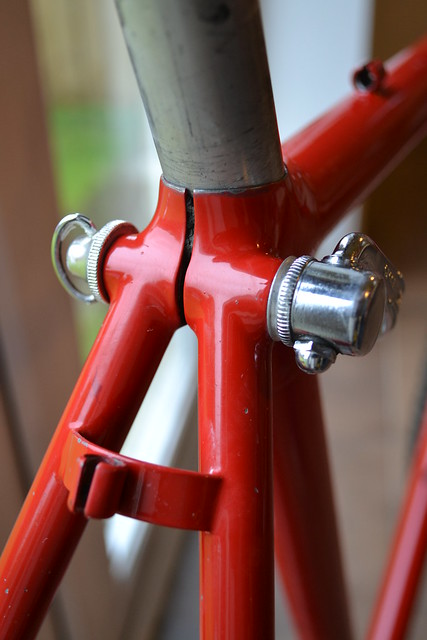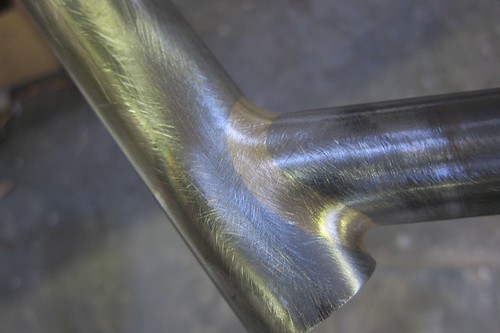- This topic has 36 replies, 23 voices, and was last updated 10 years ago by Wibble.
-
Tell me about fillet brazed joints
-
PJayFree MemberPosted 10 years ago
I rather like the look of the Pace RC104 frame; they may no longer be available, so it might be academic, but they (and the Saracen Killi Flyer, another frame I like the look of) have fillet brazed joints.
I know very little about wielding or brazing but Wikipedia suggests that brazed joints are inherently weaker than welds (how much depending on a lot of factors including the filler metal). At 16 stone and none to elegant I’d value strength and durability over looks; is there any need to be concerned about the strength (and perhaps the fatigue life of the filler) in brazed joints? I might be a bit heavy but my wheels stay on the ground.
Something else I’ve noted is both these frames spec. premium 853 steel where you pay more for the air hardening and the fact that the metal strengthens at the when welded; is there any point is using this in brazed joints (presumably a brazed 853 joint is as strong as a brazed 4130 joint).
TheBrickFree MemberPosted 10 years agoinherently weaker than welds
But they are both stronger than the base metal when done properly so its all academic. Brazed joints tend to be larger, take longer hence the expense.
IanMunroFree MemberPosted 10 years agoSomething else I’ve noted is both these frames spec. premium 853 steel where you pay more for the air hardening and the fact that the metal strengthens at the when welded;
I think it’s probably reasonably complicated. If you imagine a bit of tube welded to another, then say 3″ from the joint the temperature will be unchanged. At the joint itself the metal will be molten, and presumably will lose almost all it’s fancy properties as it get’s mixed with the filler metal, then at some short distance from the molten pool the metal will be at a temperature where it air hardens. So does that make the joint strong? Dunno.
But like TheBrick said, if done correctly it will be irrelevant.
zerocoolFull MemberPosted 10 years agoCurtis Fillet braze their frames and they are bomb proof.
Drop them an email or give them a call. Or possible contact the Frame Building Academy for info.They also look awesome
Tom KP
Ps My dad has a Fillet brazed bike from his youth (probably older than me)
jamesoFull MemberPosted 10 years agoSome Taiwanese frames are tigged under a filler-fillet. To do with tolerances.
wobbliscottFree MemberPosted 10 years agoWelding produces a brittle joint. Making steel more brittle does increase its ultimate strength, which is desirable, but reduces the materials fatigue properties, toughness and other desirable properties, so basically the weld itself and the heat affected zone (the parent material next to the weld affected by the heat of the wrld process) is usually of less desirable mechanical properties than the parent material. The weld joint itself cools quite quickly immediately after wrlding (effectively quenched) as heat energy is drawn away from the weld through conduction down the tube. this produces a microstructure of small grains with lots of grain boundaries producing a hard, brittle material. Good design and welding practice and sometimes post welding heat treatment can reduce this and make the transition from the hard and brittle weld to the nice, ductile parent material smaller.
Not sure brazing is stronger than parent material as such. In a straight tensile test the brazed joint would fail rather than the parent material. While welding actually melts and fuses the parent material, brazing does not and is basically the same process as soldering, but obviously its a pretty strong joint, strong enough for bikes, and has better fatigue resistance to a welded joint as the braze material itself is usually soft and flexible and usually Copper based, which is handy for older flexible frames that want to flex at the joints.
esselgruntfuttockFree MemberPosted 10 years agoMy old HT, ‘Trusty Rusty’ is a fillet brazed Tange Prestige job…
Which was originally built in 1992 & has taken me up more hills & down Dales (& Alps) than I can remember. It’s like Triggers brush but..none of the welds have ever failed. Ever.
Also available in white…
I’ts now on it’s Mk 8 version.
bobloFree MemberPosted 10 years agoOne of my tandems is filet brazed by one Mr George Longstaff. The finish is fantastic and when (if) I get another steel frame built, it’ll be filet brazed.
I’ve done over 25k loaded touring miles on it and it hasn’t missed a beat. I have no concerns about this method of fixing tubes together.
bencooperFree MemberPosted 10 years agoI mostly fillet braze my frames – it’s not weaker than welding if done properly, in fact it’s arguably stronger as a lower temperature is used and the smooth fillets reduce stress risers.
In reality, filleting, lugs and TIG are all good ways to join tubes together, as long as they’re done competently.
I think the confusion comes because it is true that brass is weaker than steel – so a butt brazed joint isn’t all that strong. The strength comes from the extra surface area of the fillet.
A rubbish pic of one of mine:
Framebuilding by Ben Cooper, on FlickrahwilesFree MemberPosted 10 years agospeaking as a professional materials scientist; fillet brazed joints = awesome.
the idea that they’re somehow ‘weaker’ is complete bollocks.
and they’re beautiful 🙂
mick_rFull MemberPosted 10 years agoThe brazed fillet is bigger than the TIG fillet, so the weaker material is offset by there being more of it.
I don’t know enough about the metallurgy to comment on 853 weld vs braze. Reynolds are very approachable so I suggest you drop them an email to get a proper answer. 853 has other benefits beyond the improved weld properties – e.g. higher yield so you can use thinner walls / bigger diameters without buckling to play with frame stiffness and weight.
In terms of fatigue, the fillet brazed joint has potential to be very good (flexibility, fewer stress raisers, less destructive to the parent metal etc) – hopefully compositepro will be along in a bit because I think he has some numbers to elaborate in this area. To balance this, some people quote downsides such as lots of lower level heat trapped in the joint (takes a comparatively long time to cool), annealing etc.
Talking to the man from Weldability SIF, the more basic no.1 or no.101 brazing rods were best for bike frames. Other rods with more nickel content were tougher but not recommended as they could result in brittle joints.
I’ve got a fillet brazed Kili-Flyer from 1990 which is still in one piece (although not had much use recently).
Also had a 3rd hand “internally brazed” Peugeot road bike I commuted on for ages. It eventually broke near the bottom of the seat tube (but not actually at the joint). That was a mass production technique, built with tightly mitred joints and then rings of brass rod inside the tubes that get melted out in a brazing hearth (so it forms a small fillet inside the joint and nothing on the outside). I cut it up and was amazed how tiny the fillets were (as small as a tig bead) and how it had ever lasted so long!
One thing I really like about working with brass is how repairable it is – no problem at all to completely remove and replace a tube. Trying to do this with TIG wouldn’t be very successful (welding on top of a ground down weld). I’ve got some dropouts which are now in their 3rd frame!
bencooperFree MemberPosted 10 years agoYup, I mostly use SIF 101, and it’s beautiful for fillet brazing even on stainless.
The real downside to fillet brazing is that it’s very labour-intensive – not only the brazing itself which is trickier than using lugs, but the filing afterwards which takes ages 😉
mick_rFull MemberPosted 10 years agoNo.1 is all the local places have in stock but everyone does seem to rave about 101. I’m going to try some from Ceeway when I next order tubes (I don’t make much and got to work through what I have first).
Custom buyers will always want the filed finish – for small to mass production I guess the goal is to get good enough to not file them (like Brompton, Curtis etc). No way I’ll get that clean running a propane bottle and medical oxygen generator without gas flux 🙂
bencooperFree MemberPosted 10 years agoAye, I vaguely think about gasfluxers occasionally, but general opinion seems to be that they’re a PITA unless you’re doing production work – and you don’t mind replacing hoses regularly. Flux paste is wonderful – smear it on and get stuck in, no more dipping for powder and losing flow.
I’ve also found an economiser to be really useful – so much quicker to hang up the torch then pick it up and relight.
jwtFree MemberPosted 10 years agoCan anyone give me any information about MIG brazing? I have a MIG set already and fancied having a go, but at over £100 for
a small drum of brazing wire how suitable would it be for thin wall bike tubing?( I’m assuming here that it would be better than straight MIG?)
Any on-line resource you could point me to?
Cheers.bencooperFree MemberPosted 10 years agoNever tried it, I don’t know of any framebuilder who’s ever used it – I briefly tried TIG brazing for a laugh.
I doubt it’d be any good for bike frames – I don’t even see how the brass would wet onto the steel properly.
benjiFree MemberPosted 10 years agoGot a Pace RC129, which is fillet brazed and it is lovely to look at, super smooth joints, so little hiding places for mud.
cr500domFree MemberPosted 10 years agojwt – Member
Can anyone give me any information about MIG brazing? I have a MIG set already and fancied having a go, but at over £100 for
a small drum of brazing wire how suitable would it be for thin wall bike tubing?( I’m assuming here that it would be better than straight MIG?)I`ve used it on vehicles and thin wall sheet, and its really nice, MIG welding leaves you with a really hard weld which is difficult to do anything with, grinding it back puts more heat in too.
MIG Brazing is really nice, the joint is almost as strong but does not melt the parent metal, and the braze is softer meaning less distortion and easier clean up (Flap wheel on a grinder takes it back flat in no time at all)
The main use for it now is with Repairs to shells where Hi-Tensile steels are used, as the lower temperature does not affect the material properties of the steel.
Conventional MIG would create a brittle area at the edge of the HAZ which would then fracture.A true spaceframe works with joints that are effectively flexible, as all the loads are taken by the tubes in either tension or compression.
A bike frame is slightly different but the fundamental principles of the joining methodology are the same.
The art is in the fit up and mitreing of the tubes, that’s where the strength is, the braze is merely to “Stick” the tubes in position and the fillet reduces potential stress raisers.
I`m hoping to give TIG brazing a go soon as well.jwtFree MemberPosted 10 years agoThanks Dom, I might look at finding a cheaper source of brazing wire and have a play.
MussEdFree MemberPosted 10 years agoGot one of Shand cycles’ frame on order, braze fillet looks just fine to me…
mick_rFull MemberPosted 10 years agoI threw the cut up “internally brazed” peugeot into the blaster today to see what was under the rust and paint.
The fillets are tiny but all in very good condition considering the immense age and mileage (no cracks anywhere).
Colour looks more like silver solder but can’t imagine they used silver for bog basic mass production frames – guess it must be some other kind of brazing alloy mix.
Also included a couple of before / after filing shots of my shoddy homebrew brazing 🙂
Inbred456Free MemberPosted 10 years agoBought one of the last 26er kili flyers before they went all 650b ish. Comfort wise over my Inbred my bottom is thanking me big time. I’m 6ft 4″ and about 17 stone. Its 853 fillet brazed loveliness. I will never sell this bike.
JoeGFree MemberPosted 10 years ago30+ years ago, most good road frames were lugged. Road frame geometry was well developed, and frame tube size were pretty standard. So manufacturers made lugs that covered the vast majority or road frames built at the time.
Then along came these strange things called “mountain bikes.” Their geometry was different than road bikes, and they often wanted to use bigger tube sizes as well. But these bikes were new, and probably only a passing fad, so lug manufacturers didn’t go out of their way to produce lugs for these bikes.
As a result, most early mountain bikes were fillet brazed. And I think that this lends a certain aura to fillet brazing. However, fillet brazing is labor intensive, and therefore costly. So when mountain bikes started to become popular, a lot of brands turned to TIG welding to mass produce frames to meet the growing demand. Welding is still the norm for steel frames, and brazing is mainly used on custom builds.
kayak23Full MemberPosted 10 years agoSo why is one technique used over another? Brazing over welding, tig over mig?
Presumably it’s all to do with differing materials?I know a fair bit about wood, very little about metal but find it really interesting.
bencooperFree MemberPosted 10 years agoSimple answer is there’s no right technique for everything. I braze because the equipment was reasonably cheap, it allows changes to be made easily, it’s what I learned 20 years ago, and aesthetically I think it generally looks better. I fillet braze as compared to lugs mostly because it allows complete freedom of angles and diameters.
TIG vs MIG – simply, MIG can’t do the really thin tubes and ultra precise welds needed on most bike tubing – some really cheap frames are MiGed, but almost all welded frames are TIGed.
I now have a TIG welder, that’s the next skill to master – because one big downside of brazing is that it’s pretty much for steel only.
slackaliceFree MemberPosted 10 years agoTo the OP: Why don’t you ask the manufacturer’s of the frames you are considering, if they dictate a maximum rider plus kit weight limit?
A well executed fillet brazed frame IMHO is a work of art, as are some of the lugged frames with their fancy swirly and pointy bits 🙂
mick_rFull MemberPosted 10 years agoSome (now not very common) tubes like 531 couldn’t be welded, so brazing was the norm (talking to the metallurgist at work it was to do with the combined carbon and manganese content).
I personally braze because I found it easier than TIG and had more access to the equipment.
In the day job, I spend a lot of time breaking things in a fatigue lab, and often see big variability in durability caused by small changes in weld process, technique etc. Good welds are great, but it can often be hard to know if a weld is truly good without cutting it up and / or fatigue testing (fine if you are making a batch of something). With brazing I’m more confident that there aren’t hidden problems in the joint – I can watch the brass pull into gap between the tubes and it is fairly obvious if I’ve screwed up forming the fillet (cooked flux / voids / pin holes if the zinc has been boiled etc).
Saying all that, modern TIG equipment can be very clever / automated and I’d love to try it sometime.
The topic ‘Tell me about fillet brazed joints’ is closed to new replies.
